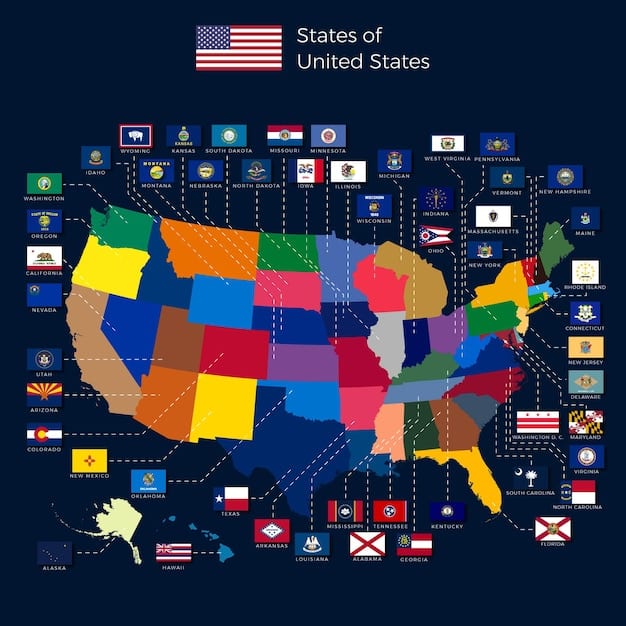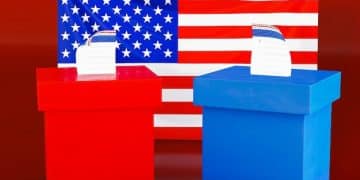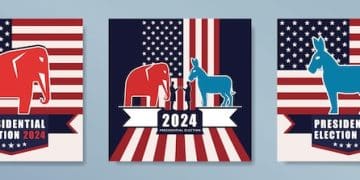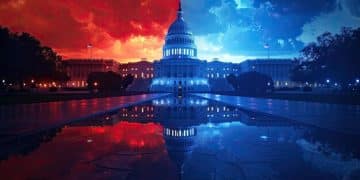US Gun Control Debate: Latest Developments Analyzed

The evolving discourse surrounding gun control legislation in the US is characterized by complex legal challenges, divergent public opinions, and varied legislative proposals at both federal and state levels, reflecting a deeply entrenched national debate.
In recent years, the debate over firearms in the United States has intensified, prompting a critical examination of new legislative efforts and their potential impacts. Analyzing the Latest Developments in the Debate Over Gun Control Legislation in the US involves understanding a complex interplay of legal precedents, political motivations, and profound societal concerns.
The Shifting Landscape of Federal Gun Control Efforts
The discussion surrounding gun control at the federal level is consistently in flux, shaped by presidential administrations, congressional priorities, and significant judicial rulings. Each mass shooting incident often reignites calls for stricter measures, pushing new proposals into the legislative spotlight.
Recent years have seen legislative attempts, though often met with significant hurdles. The Bipartisan Safer Communities Act, signed into law in 2022, marked a notable federal intervention in decades, focusing on enhanced background checks for younger buyers and funding for mental health services. While praised by some as a step forward, others criticized its limited scope.
Key Federal Legislative Initiatives
Understanding the current federal landscape requires examining specific proposals and their outcomes. Debates frequently revolve around universal background checks, bans on certain types of firearms, and red flag laws.
- Universal Background Checks: This proposal aims to close loopholes that allow private gun sales without a background check, a measure widely supported by the public but consistently stalled in Congress due to opposition from certain political factions and gun rights advocates who view it as an infringement on constitutional rights.
- Assault Weapons Bans: Efforts to ban assault weapons, often defined by features rather than their operational capabilities, resurface after high-profile mass shootings. Proponents argue these weapons are designed for mass casualties, while opponents contend they are commonly owned firearms protected by the Second Amendment.
- Red Flag Laws (Extreme Risk Protection Orders): These laws allow temporary removal of firearms from individuals deemed a danger to themselves or others by a court. While gaining bipartisan support in some states, federal implementation remains contentious, raising concerns about due process rights.
The legislative process at the federal level is inherently slow, compounded by partisan divides and the significant influence of advocacy groups on both sides of the issue. Even incremental changes require substantial political will and compromise, often only emerging after particularly tragic events.
The role of the judiciary, particularly the Supreme Court, profoundly impacts the parameters of federal gun control. Recent rulings have affirmed the individual right to bear arms while also acknowledging the possibility of reasonable regulation, setting complex precedents for future legislation.
State-Level Divergence and Innovation

While federal efforts often stall, state legislatures have become laboratories for diverse approaches to gun control. This has led to a patchwork of laws across the country, where residents in one state may face vastly different regulations than those in a neighboring one.
States with stricter gun laws, often those with Democratic majorities, continue to pass legislation ranging from expanded background checks and waiting periods to limitations on magazine capacity and bans on certain firearm types. Conversely, states with Republican majorities often prioritize gun rights, enacting laws that allow permitless carry or preempt local gun ordinances.
Variations in State Legislative Approaches
The diversity in state-level approaches is a defining characteristic of the US gun control debate. Each state tailors its laws based on local political climate, public sentiment, and historical context.
- California’s Comprehensive Regulations: Often cited as having some of the strictest gun laws, California employs a wide array of regulations including universal background checks, bans on assault weapons, red flag laws, and strict permitting requirements for purchasing and owning firearms. Their approach aims to reduce gun violence through broad regulatory frameworks.
- Texas’s Emphasis on Gun Rights: In contrast, Texas has consistently expanded gun rights, being one of several states to adopt permitless carry, allowing individuals to carry handguns without a license. This reflects a commitment to Second Amendment interpretations that prioritize the right to bear arms with minimal government intervention.
- Emergence of Red Flag Laws: A growing number of states, even some with traditionally pro-gun stances, have adopted red flag laws. This signifies a potential area of bipartisan consensus, as these laws are seen by some as a targeted approach to preventing violence while respecting law-abiding gun owners.
The impact of these disparate state laws is a subject of ongoing debate and research. Advocates for stricter control argue that strong state laws lead to lower rates of gun violence, while opponents claim they disproportionately affect law-abiding citizens without significantly deterring crime.
Interstate gun trafficking remains a challenge, as firearms purchased legally in one state with lax laws can easily be transported to states with stricter regulations. This highlights the limitations of a purely state-by-state approach without corresponding federal action.
The Evolving Role of Public Opinion
Public opinion on gun control is complex and can be highly reactive to major events. While general support for some measures, like universal background checks, remains high, specific proposals often reveal deeper divisions. Understanding these nuances is crucial for analyzing the political feasibility of new legislation.
Polls consistently show strong bipartisan support for universal background checks, but this consensus often breaks down when discussing more restrictive measures such as bans on certain types of firearms or confiscation policies. The perceived threat to Second Amendment rights is a significant factor shaping public sentiment, especially among gun owners.
Divisions and Consensus in Public Support
While overall public support for gun control has fluctuated, some trends are apparent. The aftermath of significant gun violence incidents often sees a temporary surge in support for stricter laws, which tends to stabilize over time. However, certain measures consistently command broader agreement.
- Background Checks: Measures requiring background checks for all gun sales consistently show high levels of public support, often exceeding 80% across demographic and political lines. This indicates a rare area of consensus in an otherwise polarizing debate.
- Mental Health Interventions: There is increasing public recognition of the link between mental health and gun violence. Support for enhanced mental health services and early intervention programs, often coupled with gun control measures, has grown significantly.
- Arming School Personnel: Proposals to arm school teachers or staff, while supported by some gun rights advocates as a deterrent, generally face mixed public opinion, with concerns about safety and training often outweighing perceived benefits.
The role of media in shaping public opinion cannot be overstated. The framing of gun violence incidents and legislative debates profoundly influences how the public perceives the issue. Advocacy groups on both sides also invest heavily in public relations campaigns to sway sentiment.
Generational and demographic shifts also play a role. Younger generations and urban populations tend to favor stricter gun controls, while older, rural populations often prioritize gun rights. These demographic divides contribute to the complex and often intractable nature of the debate.
The Impact of Judicial Rulings on Gun Rights
The judiciary, particularly the Supreme Court, has played a pivotal role in shaping the current landscape of gun control in the United States. Landmark decisions have interpreted the Second Amendment, setting the boundaries for what types of gun regulations are permissible.
The 2008 District of Columbia v. Heller decision affirmed an individual’s right to possess firearms for self-defense, a significant shift from previous interpretations that linked the right solely to militia service. This ruling, however, also acknowledged that the Second Amendment right is not unlimited and permits reasonable regulations.
Defining Moments in Second Amendment Jurisprudence
Subsequent Supreme Court cases have further refined the understanding of the Second Amendment, impacting state and federal legislative powers. These rulings establish precedents that lower courts must follow when evaluating gun control laws.
- McDonald v. City of Chicago (2010): This decision incorporated the Second Amendment to the states, meaning that state and local governments are also bound by the individual right to bear arms. This expanded the reach of Heller and limited the regulatory authority of states.
- New York State Rifle & Pistol Association Inc. v. Bruen (2022): This landmark ruling struck down New York’s restrictive concealed-carry law, establishing a new legal standard. It requires that gun regulations be consistent with the historical understanding of the Second Amendment from when it was adopted. This has led to challenges against various existing gun laws nationwide.
The Bruen decision, in particular, has created significant uncertainty, prompting lower courts to re-evaluate gun control laws through a historical lens. This has led to a flurry of legal challenges, with many current regulations facing intense scrutiny based on their historical analogues.
The judicial branch’s interpretations constantly reshape the parameters of legislative action, creating a dynamic environment where laws passed today might be struck down tomorrow based on evolving legal precedents. This highlights the importance of understanding the interplay between legal precedent and legislative intent.
The Role of Advocacy Groups and Political Action
Advocacy groups on both sides of the gun control debate exert considerable influence on public discourse, legislative processes, and election outcomes. Organizations like the National Rifle Association (NRA) on one side and groups like Everytown for Gun Safety and Moms Demand Action on the other are central to the political dynamics.
These groups engage in extensive lobbying, campaign contributions, public awareness campaigns, and grassroots organizing. Their efforts can significantly shape policy debates, particularly during election cycles, where gun control often emerges as a key wedge issue.
Influencing the Political Landscape
The strategies employed by gun rights and gun control advocacy groups are sophisticated and multi-faceted, aiming to influence policy, public opinion, and electoral outcomes. Their work is a core component of the ongoing debate.
- Lobbying and Campaign Finance: Both sides invest heavily in lobbying efforts, attempting to persuade lawmakers to support or oppose specific legislation. Campaign contributions are also a significant tool, aimed at supporting candidates aligned with their positions and opposing those who are not.
- Public Awareness Campaigns: Advocacy groups run extensive campaigns to shape public opinion, using advertising, social media, and traditional media outlets. These campaigns aim to frame the debate in a way that aligns with their objectives, whether emphasizing Second Amendment rights or the need for public safety.
- Grassroots Mobilization: Organizing at the local level, through protests, letter-writing campaigns, and voter registration drives, is crucial for both sides. This grassroots activism helps to energize their bases and demonstrate strong public support for their positions.
The effectiveness of these groups can vary depending on political cycles, public sentiment following major events, and their financial resources. However, their consistent presence ensures that gun control remains a perennially active issue in American politics.
The internal dynamics of these organizations, including leadership changes and financial health, can also impact their advocacy effectiveness. For instance, the NRA has faced internal strife and financial challenges in recent years, potentially impacting its traditional dominance in the gun rights movement.
Looking Ahead: Potential Future Developments
Projecting the future of gun control legislation in the US requires considering various factors, including political shifts, judicial interpretations, technological advancements in firearms, and evolving societal norms. The debate is unlikely to resolve neatly but will continue to adapt to new challenges and information.
One area of increasing focus is the role of technology. The rise of 3D-printed firearms and “ghost guns” (untraceable, unserialized firearms) presents new regulatory challenges that current laws may not adequately address. Legislators are grappling with how to regulate these innovations, often facing significant legal and practical difficulties.
Emerging Trends and Unforeseen Challenges
The gun control debate is dynamic, influenced by societal changes and technological innovations that introduce new complexities regularly.
- Regulation of “Ghost Guns”: The proliferation of untraceable firearms manufactured at home or through kits poses a significant challenge. Federal and state governments are beginning to enact regulations, but enforcement remains difficult, and legal challenges are frequent.
- Impact of Mass Shootings: Sadly, each major incident of gun violence often triggers renewed calls for legislative action. The nature of these incidents can dictate the specific types of controls that gain prominence in public discourse and legislative proposals.
- Role of Mental Health: There is a growing bipartisan recognition of the need to address mental health as part of the gun violence prevention strategy. Future legislation may increasingly integrate mental health support and intervention programs, potentially fostering more common ground.
Litigation will continue to be a primary battleground. The Supreme Court’s Bruen decision has opened the door for numerous challenges to existing gun laws, and lower courts will spend years grappling with the new historical test it established. This legal uncertainty will likely complicate future legislative efforts.
The 2024 and subsequent election cycles will also be pivotal. The stances of presidential candidates, congressional hopefuls, and state-level politicians on gun rights and control will significantly influence the legislative agenda and the direction of policy for years to come. The debate over guns remains a defining feature of American politics.
| Key Point | Brief Description |
|---|---|
| ⚖️ Federal Legislation | Bipartisan efforts like the Safer Communities Act represent incremental changes amidst ongoing debates on universal checks and assault weapon bans. |
| 🌎 State-Level Approaches | States implement diverse laws, from strict regulations in California to expansive gun rights in Texas, creating a complex legal mosaic. |
| 🏛️ Judicial Impact | Supreme Court rulings, notably Bruen, have redefined Second Amendment interpretations, challenging existing gun laws and setting new precedents. |
| 📈 Future Outlook | Debate is evolving with technological challenges (ghost guns) and political shifts, ensuring ongoing legislative and legal battles. |
Frequently Asked Questions About US Gun Control
▼
The Bipartisan Safer Communities Act, signed into law in 2022, is a federal gun safety bill that notably enhances background checks for gun buyers under 21, provides funding for state red flag laws, and invests in mental health services and school safety initiatives. It was the most significant federal gun control legislation passed in decades.
▼
The 2022 Supreme Court ruling in New York State Rifle & Pistol Association Inc. v. Bruen established that gun control laws must align with the historical understanding of the Second Amendment. This ruling struck down New York’s restrictive concealed-carry law and has led to numerous legal challenges against various existing state and federal gun regulations nationwide, requiring courts to assess them through a historical lens.
▼
Red flag laws, also known as extreme risk protection orders (ERPOs), allow temporary removal of firearms from individuals deemed by a court to be an imminent danger to themselves or others. These laws typically involve a legal process where family members or law enforcement can petition a court for an order, aiming to prevent violence by temporarily disarming potentially dangerous individuals.
▼
Public opinion on gun control is deeply divided due to a complex interplay of factors including constitutional interpretations, individual rights versus public safety concerns, political affiliations, cultural values, and experiences with gun violence. While there’s broad support for some measures like universal background checks, more restrictive proposals face strong opposition from those who prioritize Second Amendment rights.
▼
“Ghost guns” are homemade firearms assembled from parts or kits, often lacking serial numbers, making them untraceable by law enforcement. They are a growing concern because their untraceable nature can complicate criminal investigations and make it easier for individuals prohibited from owning firearms to acquire them, bypassing background checks and existing regulations designed to prevent gun violence.
Conclusion
The debate over gun control legislation in the US remains a multifaceted issue, characterized by significant legal, political, and social complexities. While federal progress has been incremental, states continue to innovate with diverse legislative approaches, from stricter regulations to expanded gun rights. Judicial rulings, particularly the Supreme Court’s recent decisions, consistently redefine the boundaries of permissible gun control, while advocacy groups on both sides vigorously shape public opinion and political action. As new technologies like “ghost guns” emerge, and the nation continues to grapple with gun violence, the dynamic interplay of these forces ensures that the discussion will remain at the forefront of American policy and public discourse for the foreseeable future, demanding continuous analysis and careful consideration of all viewpoints.





